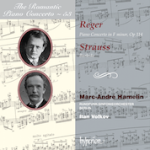Max Reger wrote, “my Piano Concerto is going to be misunderstood for years. The musical language is too austere and too serious; it is, so to speak, a pendant to Brahms’ D minor piano concerto.” The problem is that for all of Reger’s unquestionable workmanship, lavish orchestration, and highly refined handling of chromatic harmony, he’s a most unmemorable tunesmith. Moreover, the piano part’s tremendous technical challenges offer little pay off in terms of scintillation and surface display. Still, the work continues to fascinate a handful of pianists in each generation, and because recordings of the concerto are few and far between, any new version is bound to get attention.
On balance, Marc-André Hamelin and Ilan Volkov offer the finest interpretation since Serkin/Ormandy. So far as the piano part is concerned, Hamelin’s refinement, tonal palette, and wide-ranging arsenal of articulations conveys more expressive variety next to the comparably proficient yet bleak and monochrome Michael Korstick, or the warmer-toned yet square Gerhard Oppitz. The first movement’s thick chordal climaxes are a case in point, where Hamelin’s shapelier phrasing best communicates the composer’s “molto agitato” wishes. Another good example can be found in the finale.
There are two ways to project what little humor Reger could muster in music that I like to describe as a “cakewalk for pachyderms”: one is to adapt Serkin’s lean, angular pose; another is to clip the staccato notes to the point of exaggeration and similarly play up the accented notes, which Hamelin and Volkov do marvelously. Hamelin’s subtle voicings and careful adherence to Reger’s detailed expressive markings also yield greater animation and character in the central Largo movement, although there’s something to be said for Korstick’s markedly slower tempo and concentrated reserve. Nor do the Berlin Radio Symphony Orchestra winds blend to the mellifluous degree of their Bamberg (Oppitz) and Munich (Korstick) colleagues.
The Strauss Burleske is a welcome disc mate (some collectors may remember a similar and excellent 1998 Reger/Strauss coupling from Barry Douglas and Marek Janowski on RCA; it ought to be reissued). Hamelin’s long-lined legato touch in the unaccompanied passages stands out, and so does his witty, debonair timing and placement of short chords so that the subsequent silences make you smile. This is why Hamelin is the Bugs Bunny of the piano. If you want Daffy Duck, try Martha Argerich’s wilder, more impetuous, and just as technically astonishing rendition from the 1992 New Year’s Eve Concert with a more incisive, tonally sumptuous accompaniment from Claudio Abbado and the Berlin Philharmonic. In all, this release is one of the strongest entries in Hyperion’s landmark Romantic Piano Concerto series, and is highly recommended. [4/25/2011]
































